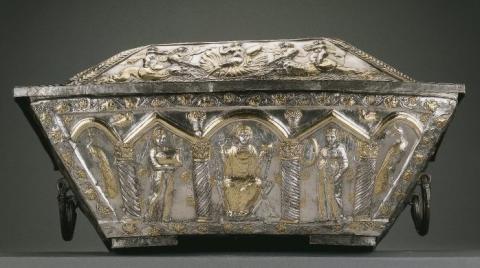28 XI: Grace Stafford (Oxford), Adornment as Public Spectacle in Late Antique Art and Culture

Abstracts
Adornment as Public Spectacle in Late Antique Art and Culture (28 XI, 16.45, Biblioteka Papirologii i Prawa Rzymskiego)
The cultivation of beauty is consistently considered to have been of paramount importance for ancient women. In this context, it is unsurprising that perhaps the most widely recognisable image of a non-imperial woman from Late Antiquity is the Projecta Casket, fascinating for its portrayal of the ‘private life’ of a late-antique woman. The depiction of Projecta’s toilet and others like it have been placed firmly in the domestic sphere of women, mysterious and normally hidden from the outside world. But just how private was the female toilet in this period?
This paper argues that we have misunderstood these images, having been too ready to accept adornment as inherently feminine, private, and ultimately linked to seduction and sexuality. A close reading of both the iconography and relevant literary sources, however, indicates that they do not represent private domestic scenes, but the performance of adornment in the context of the public bathhouse. I argue that such bathing ceremonies were part of the growing culture of spectacle in Late Antiquity more generally, a chance for individuals of both sexes to assert their position in the social hierarchy. This reveals an important new facet of the public construction and expression of power in late antique society, an area normally thought to be reserved exclusively for men.
Female Pilgrimage in Late Antiquity (29 XI, 16.45, IH, s. B)
Elite female pilgrims are some of the most celebrated and well-studied women of Late Antiquity. The narratives surrounding women such as Egeria or Paula constitute a large proportion of our knowledge about pilgrimage practice in general and have formed the focus for the study of gender and pilgrimage in particular. This bias towards famous literary sources, however, obscures our understanding of the “normal” women who made up the majority of female pilgrims. This paper seeks to redress this imbalance by integrating material and textual evidence from three sites of early Christian pilgrimage in order to better understand the interconnected relationships women had with these shrines. Evidence from the shrines of Saint Menas at Abu Mina, Saint Simeon the Stylite the Elder at Qal’at Sem’an, and Saint Thecla at Seleucia show how gender could shape pilgrimage experience and how sites recognised women as a specific visitor demographic and responded to their needs. This was achieved through the provision of narratives related to the dangers of pilgrimage, segregated spaces, and products for women to purchase. In a wider sense, this paper argues that many women in Late Antiquity had greater freedom to travel and move in public spaces than is often recognised, and that this freedom was not necessarily dependent on marital or sexual status.
